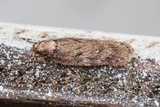Depressaria albipunctella ([Denis & Schiffermüller], 1775) Species
Last modified: Dec. 8, 2025, 4:41 p.m.
A very rare and local species in Belgium.
Details
- Classification
- Family: Depressariidae > Subfamily: Depressariinae > Genus: Depressaria > Species: Depressaria albipunctella
- Vernacular names
- Witstipplatlijfje (NL)
- Synonyms
- Depressaria albipuncta Haworth, 1811 and Depressaria aegopodiella (Hübner, 1825)
- First mention in Belgium
- De Fré Ch. 1858. Catalogue des Microlépidoptères de la Belgique. — Annales de la Société entomologique belge 2: 45–162. On page 129 (as D.[epressaria] Albipunctella. H.). view page
- Status
-
Native
Distribution
Caterpillar
Bright green with a thin darker green dorsal line; head capsule yellowish green; prothoracic plate green with a few black dots; pinacula pale green.
Cocoon/pupa
A loosely spun cocoon in the soil or among detritus; pupa brown.
Bionomics
The caterpillar lives in a loose upper-surface silk spinning of a leaflet; the sides of the leaflet are drawn upwards but most of the time not closing into a tube; full-grown in June–July.
The last instar drops to the ground and spins a loose cocoon in the soil or among detritus in which it pupates.
The adult moths hibernate.
The adults are active at night, readily come to light, and can be found occasionally on sugar.
Flight periods
One long generation a year from early August till late November and after hibernating again from February/March till May or later.
Observed on
- Host plant (species):
- Daucus carota, Torilis japonica, Anthriscus sylvestris and Chaerophyllum temulum
The preferred food plants are Daucus carota or Torilis japonica. The species is rarely observed on: Anthriscus sylvestris or Chaerophyllum temulum.
Habitat
Open grassland and scrub where the food plants grow, ruderal places.








